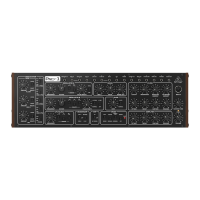Front Panel
Introduction
This section explains the "modules" outlined on the front panel. The front panel is divided into
"voice" and "modulation" sections. The basic voice is discussed first, then modulation. Signal
flow, the alternatives of each switch, and ranges of each knob are described.
The Voice
As an analogue voltage-controlled synthesiser voice, the Pro-One can be understood at its
most general level in terms of three functions: audio waveshape generation, modification, and
control.
The diagram shows the voice signal flow. As mentioned above (About the Pro-One), OSC A
and OSC B are the principal sound generators. They are supplemented by the NOISE source
(for unpitched sounds such as "surf") or an external audio input which bypasses the NOISE
source. (To learn how to use the external audio input, see the Top Panel section).
The MIXER is a modifier. It sets OSC A, OSC B, and NOISE (or EXT audio) levels and
combines them into one signal which enters the FILTER. The FILTER also functions normally as
a modifier, by cutting off the high-frequency components of input audio signals. However, by
feeding a sufficient amount of FILTER output back to its input with the RESONANCE control,
the FILTER will become a pitch generator at its CUTOFF frequency.

